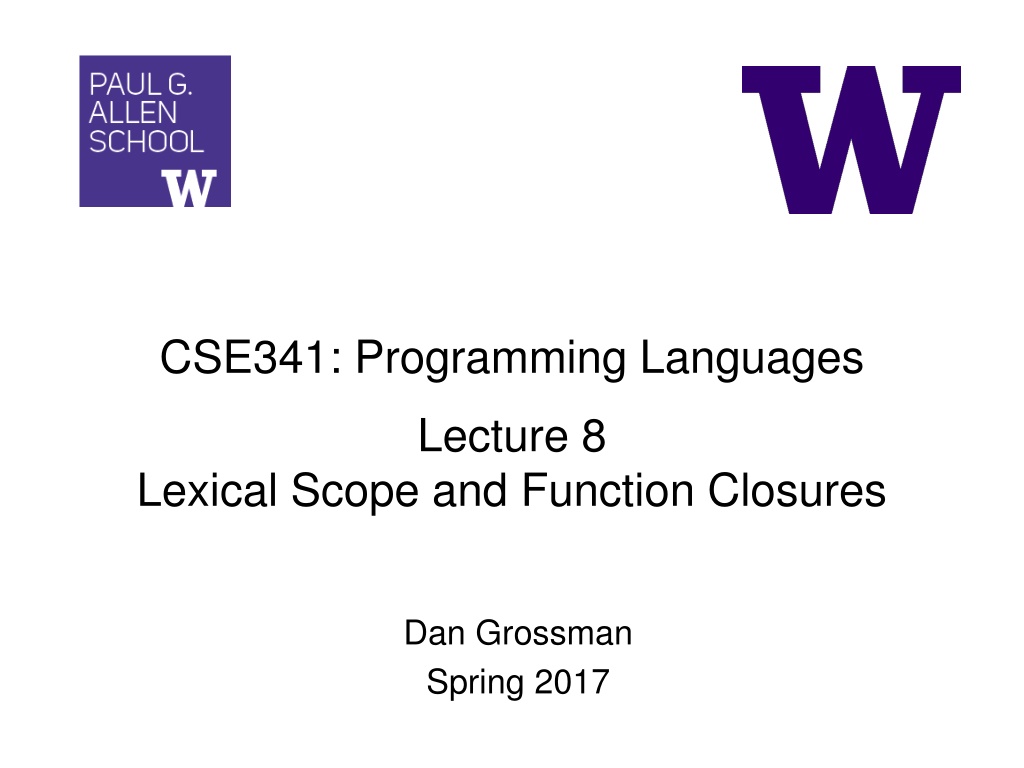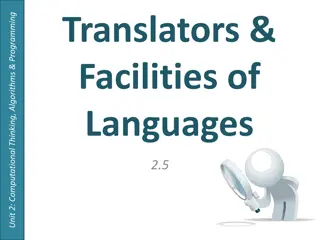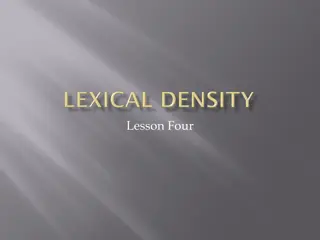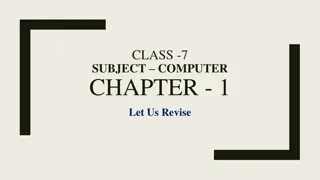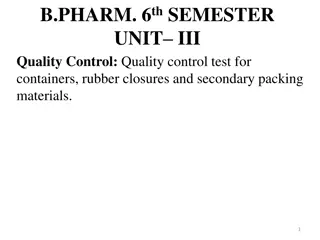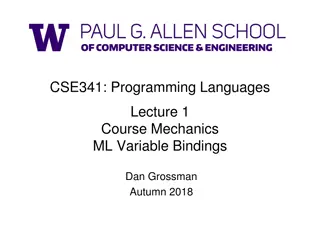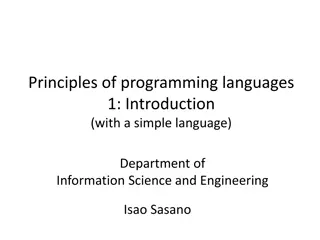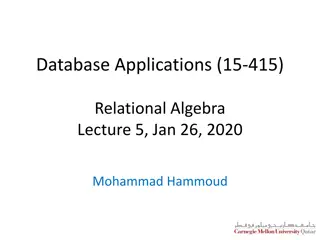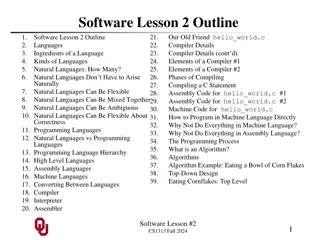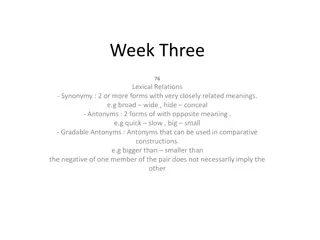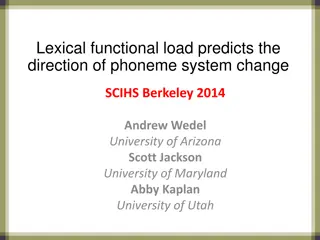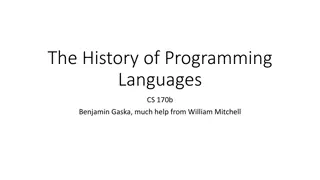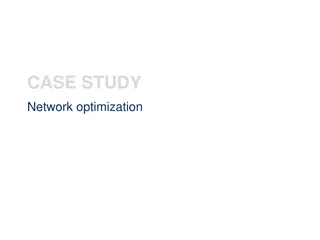Understanding Lexical Scope and Function Closures in Programming Languages
Lexical scope allows functions to access bindings where they were defined, not where they were called. Function closures enable functions to be evaluated in old environments, even when those environments aren't available anymore. This concept is crucial for homework, exams, and competent programming in the field of programming languages. Spring 2017 CSE341: Programming Languages.
Download Presentation

Please find below an Image/Link to download the presentation.
The content on the website is provided AS IS for your information and personal use only. It may not be sold, licensed, or shared on other websites without obtaining consent from the author. Download presentation by click this link. If you encounter any issues during the download, it is possible that the publisher has removed the file from their server.
E N D
Presentation Transcript
CSE341: Programming Languages Lecture 8 Lexical Scope and Function Closures Dan Grossman Spring 2017
Very important concept We know function bodies can use any bindings in scope But now that functions can be passed around: In scope where? Where the function was defined (not where it was called) This semantics is called lexical scope There are lots of good reasons for this semantics (why) Discussed after explaining what the semantics is (what) Later in course: implementing it (how) Must get this for homework, exams, and competent programming Spring 2017 CSE341: Programming Languages 2
Example Demonstrates lexical scope even without higher-order functions: (* 1 *) val x = 1 (* 2 *) fun f y = x + y (* 3 *) val x = 2 (* 4 *) val y = 3 (* 5 *) val z = f (x + y) Line 2 defines a function that, when called, evaluates body x+y in environment where x maps to 1 and y maps to the argument Call on line 5: Looks up f to get the function defined on line 2 Evaluates x+y in current environment, producing 5 Calls the function with 5, which evaluates the body in the old environment, producing 6 Spring 2017 CSE341: Programming Languages 3
Closures How can functions be evaluated in old environments that aren t around anymore? The language implementation keeps them around as necessary Can define the semantics of functions as follows: A function value has two parts The code (obviously) The environment that was current when the function was defined This is a pair but unlike ML pairs, you cannot access the pieces All you can do is call this pair This pair is called a function closure A call evaluates the code part in the environment part (extended with the function argument) Spring 2017 CSE341: Programming Languages 4
Example (* 1 *) val x = 1 (* 2 *) fun f y = x + y (* 3 *) val x = 2 (* 4 *) val y = 3 (* 5 *) val z = f (x + y) Line 2 creates a closure and binds f to it: Code: take y and have body x+y Environment: x maps to 1 (Plus whatever else is in scope, including f for recursion) Line 5 calls the closure defined in line 2 with 5 So body evaluated in environment x maps to 1 extended with y maps to 5 Spring 2017 CSE341: Programming Languages 5
Coming up: Now you know the rule: lexical scope Next steps: (Silly) examples to demonstrate how the rule works with higher- order functions Why the other natural rule, dynamic scope, is a bad idea Powerful idioms with higher-order functions that use this rule Passing functions to iterators like filter Next lecture: Several more idioms Spring 2017 CSE341: Programming Languages 6
The rule stays the same A function body is evaluated in the environment where the function was defined (created) Extended with the function argument Nothing changes to this rule when we take and return functions But the environment may involve nested let-expressions, not just the top-level sequence of bindings Makes first-class functions much more powerful Even if may seem counterintuitive at first Spring 2017 CSE341: Programming Languages 7
Example: Returning a function (* 1 *) val x = 1 (* 2 *) fun f y = (* 2a *) let val x = y+1 (* 2b *) in fn z => x+y+z end (* 3 *) val x = 3 (* 4 *) val g = f 4 (* 5 *) val y = 5 (* 6 *) val z = g 6 Trust the rule: Evaluating line 4 binds to g to a closure: Code: take z and have body x+y+z Environment: y maps to 4, x maps to 5 (shadowing), So this closure will always add 9 to its argument So line 6 binds 15 to z Spring 2017 CSE341: Programming Languages 8
Example: Passing a function (* 1 *) fun f g = (* call arg with 2 *) (* 1a *) let val x = 3 (* 1b *) in g 2 end (* 2 *) val x = 4 (* 3 *) fun h y = x + y (* 4 *) val z = f h Trust the rule: Evaluating line 3 binds h to a closure: Code: take y and have body x+y Environment: x maps to 4, f maps to a closure, So this closure will always add 4 to its argument So line 4 binds 6 to z Line 1a is as stupid and irrelevant as it should be Spring 2017 CSE341: Programming Languages 9
Why lexical scope Lexical scope: use environment where function is defined Dynamic scope: use environment where function is called Decades ago, both might have been considered reasonable, but now we know lexical scope makes much more sense Here are three precise, technical reasons Not a matter of opinion Spring 2017 CSE341: Programming Languages 10
Why lexical scope? 1. Function meaning does not depend on variable names used Example: Can change body of f to use q everywhere instead of x Lexical scope: it cannot matter Dynamic scope: depends how result is used fun f y = let val x = y+1 in fn z => x+y+z end Example: Can remove unused variables Dynamic scope: but maybe some g uses it (weird) fun f g = let val x = 3 in g 2 end Spring 2017 CSE341: Programming Languages 11
Why lexical scope? 2. Functions can be type-checked and reasoned about where defined Example: Dynamic scope tries to add a string and an unbound variable to 6 val x = 1 fun f y = let val x = y+1 in fn z => x+y+z end val x = "hi" val g = f 7 val z = g 4 Spring 2017 CSE341: Programming Languages 12
Why lexical scope? 3. Closures can easily store the data they need Many more examples and idioms to come fun greaterThanX x = fn y => y > x fun filter (f,xs) = case xs of [] => [] | x::xs => if f x then x::(filter(f,xs)) else filter(f,xs) fun noNegatives xs = filter(greaterThanX ~1, xs) fun allGreater(xs,n) = filter(fn x => x > n, xs) Spring 2017 CSE341: Programming Languages 13
Does dynamic scope exist? Lexical scope for variables is definitely the right default Very common across languages Dynamic scope is occasionally convenient in some situations So some languages (e.g., Racket) have special ways to do it But most do not bother If you squint some, exception handling is more like dynamic scope: raise e transfers control to the current innermost handler Does not have to be syntactically inside a handle expression (and usually is not) Spring 2017 CSE341: Programming Languages 14
When things evaluate Things we know: A function body is not evaluated until the function is called A function body is evaluated every time the function is called A variable binding evaluates its expression when the binding is evaluated, not every time the variable is used With closures, this means we can avoid repeating computations that do not depend on function arguments Not so worried about performance, but good example to emphasize the semantics of functions Spring 2017 CSE341: Programming Languages 15
Recomputation These both work and rely on using variables in the environment fun allShorterThan1 (xs,s) = filter(fn x => String.size x < String.size s, xs) fun allShorterThan2 (xs,s) = let val i = String.size s in filter(fn x => String.size x < i, xs) end The first one computes String.size once per element of xs The second one computes String.size s once per list Nothing new here: let-bindings are evaluated when encountered and function bodies evaluated when called Spring 2017 CSE341: Programming Languages 16
Another famous function: Fold fold (and synonyms / close relatives reduce, inject, etc.) is another very famous iterator over recursive structures Accumulates an answer by repeatedly applying f to answer so far fold(f,acc,[x1,x2,x3,x4]) computes f(f(f(f(acc,x1),x2),x3),x4) fun fold (f,acc,xs) = case xs of [] | x::xs => fold(f, f(acc,x), xs) => acc This version folds left ; another version folds right Whether the direction matters depends on f (often not) val fold = fn : ('a * 'b -> 'a) * 'a * 'b list -> 'a Spring 2017 CSE341: Programming Languages 17
Why iterators again? These iterator-like functions are not built into the language Just a programming pattern Though many languages have built-in support, which often allows stopping early without resorting to exceptions This pattern separates recursive traversal from data processing Can reuse same traversal for different data processing Can reuse same data processing for different data structures In both cases, using common vocabulary concisely communicates intent Spring 2017 CSE341: Programming Languages 18
Examples with fold These are useful and do not use private data fun f1 xs = fold((fn (x,y) => x+y), 0, xs) fun f2 xs = fold((fn (x,y) => x andalso y>=0), true, xs) These are useful and do use private data fun f3 (xs,hi,lo) = fold(fn (x,y) => 0, xs) fun f4 (g,xs) = fold(fn (x,y) => x andalso g y), true, xs) x + (if y >= lo andalso y <= hi then 1 else 0)), Spring 2017 CSE341: Programming Languages 19
Iterators made better Functions like map, filter, and fold are much more powerful thanks to closures and lexical scope Function passed in can use any private data in its environment Iterator doesn t even know the data is there or what type it has Spring 2017 CSE341: Programming Languages 20
